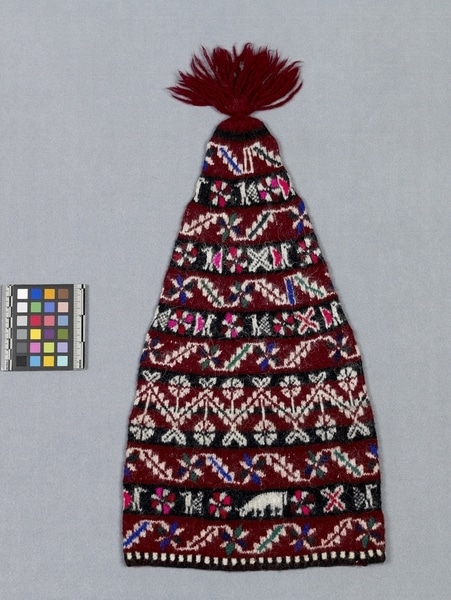Hat Item Number: Sf932 from the MOA: University of British Columbia


Description
A conical stocking cap with alternating dark red and dark blue patterned bands. The red pattern bands all repeat a six part floret joined by oblique stepped lines. Most of the navy blue bands alternate the eight part circle with other motifs, including profile birds, crosses, butterflies and cows. The top has a yarn tassel and the bottom has a band of checkered squares.
History Of Use
The colour, extent of patterning, shape and the manner in which chullus or caps are worn signal differences in age, sex and status of the wearer. Females wear chullus in early childhood, but only males wear them later in life. Traditionally, knitting is done only by men and boys, formerly for chullus, but recently also for vest fronts, coin purses, gloves, ties, vests and sweaters which are sold to tourists. The fully patterned hat is worn only by married men. Married men wear the tassel hanging to the right side.
Specific Techniques
Plain knitting done circularly on five needles with extra colours carried on the inside for local colour areas.
Cultural Context
married men
Iconographic Meaning
The range of motifs refers to local geography and landmarks, ecology, fecundity as well as luck. The six part circle refers to the division of land into six sections on Taquile and the rotation of crops and fallow periods. The s or z shaped reverse curve can refer to the boat port or other objects that contain the idea of turning or returning such as a recurved potato hook. The cross or x-shape can refer to the warping cross in weaving, the crossroads or other intersections. The stepped diagonal lines refer to stairs on the steep island, but also to the connection with the afterworld in a particular myth. The motifs represent basic concepts or interrelationships and may have different particular references.
Narrative
Made by Mariano Flores Machaca for sale in the Taquile Textile Co-operative, Association Artesanal "Manco Capac," Taquile. The relative coarseness of the knitting was a subject for remark by his relatives who said he used thick yarns so he would be finished sooner.
Item History
- Made by Mariano Flores Machaca (Maker) in Taquile, Puno, Peru during 1981
- Collected by Mary Frame during 1982
- Owned by Mary Frame before February 10, 1983
- Received from Mary Frame (Seller) and Museum of Anthropology Shop Volunteers (Funding source) on February 10, 1983
What
- Name
- Hat
- Identification Number
- Sf932
- Type of Item
- hat
- Material
- synthetic fibre, wool fibre and dye
- Manufacturing Technique
- knitted, sewn, plied and spun
- Overall
- height 50.2 cm, width 24.0 cm
Who
- Culture
- Quechua
- Creator
- Mariano Flores Machaca (Maker)
- Field Collector
- Mary Frame
- Previous Owner
- Mary Frame
- Received from
- Mary Frame (Seller) and Museum of Anthropology Shop Volunteers (Funding source)
Where
- Holding Institution
- MOA: University of British Columbia
- Made in
- Taquile, Puno, Peru
When
- Creation Date
- during 1981
- Collection Date
- during 1982
- Ownership Date
- before February 10, 1983
- Acquisition Date
- on February 10, 1983
Other
- Item Classes
- textiles
- Condition
- good
- Accession Number
- 0861/0002